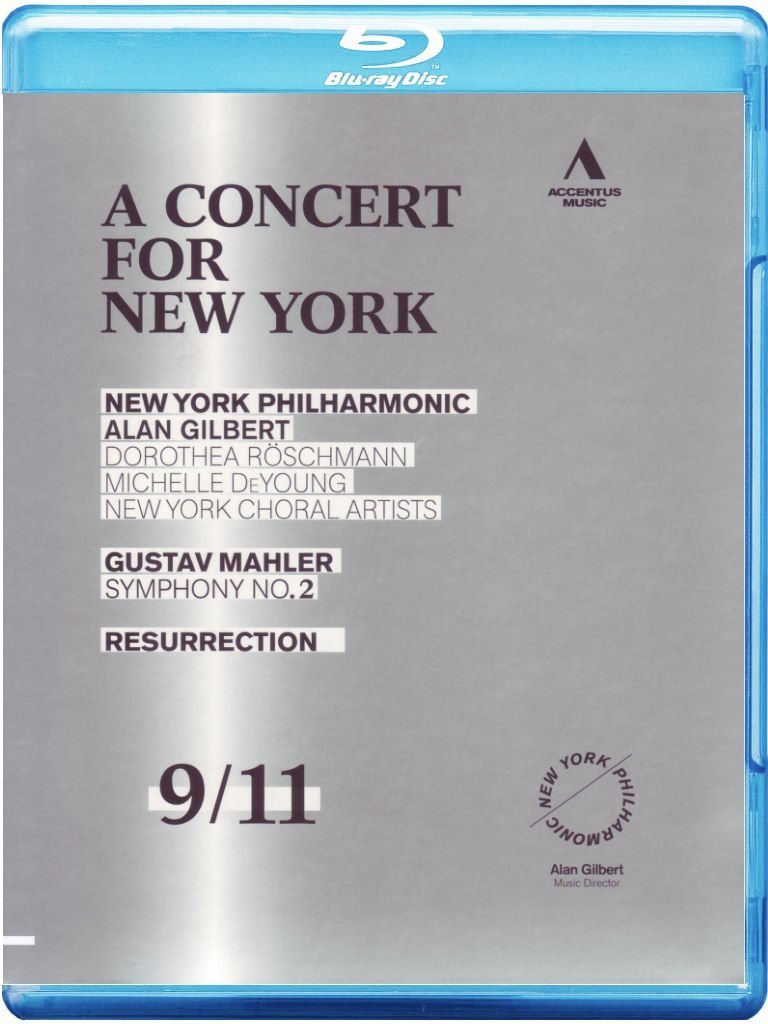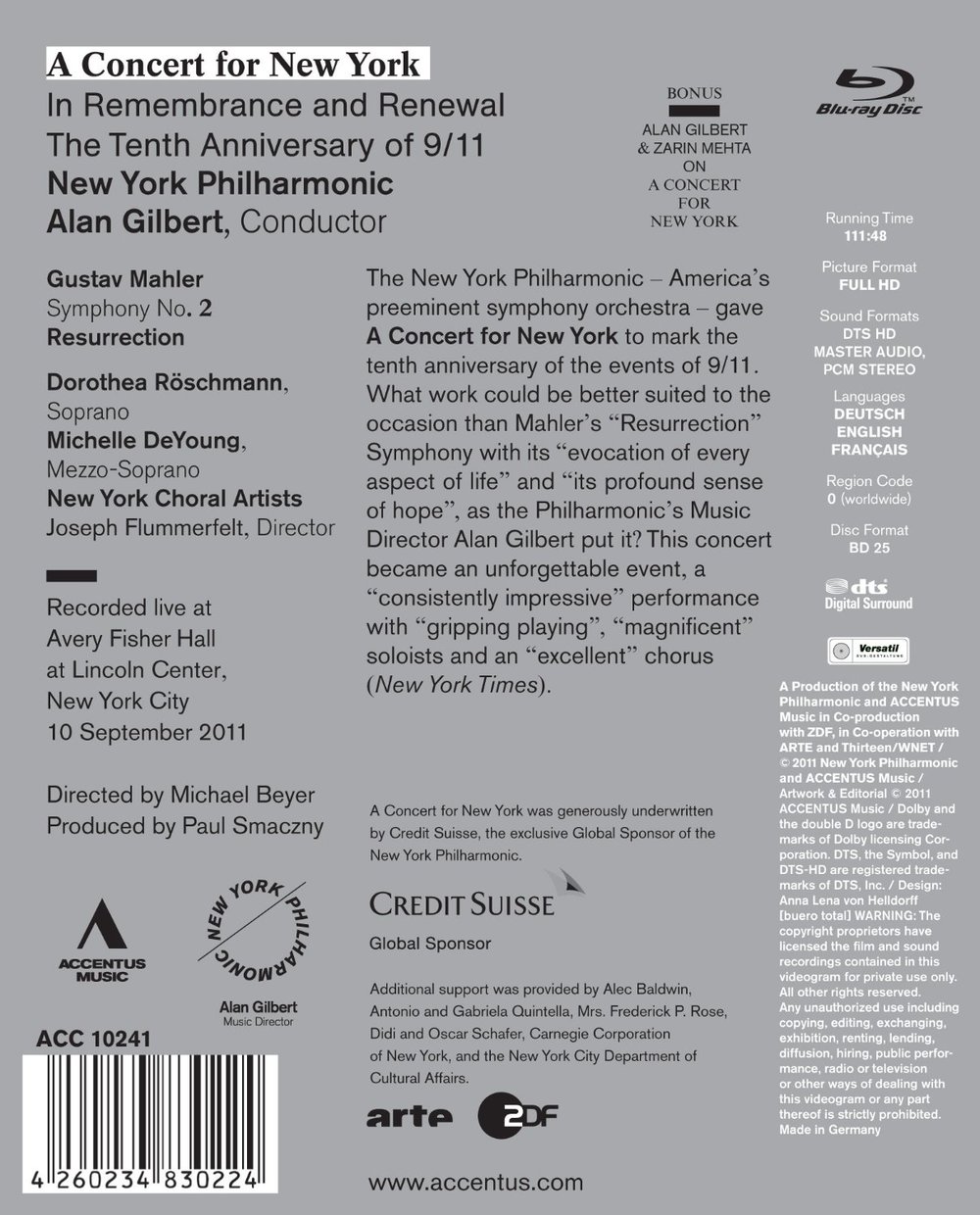

Mahler Symphony No. 2 "Resurrection". Alan Gilbert conducts the New York Philharmonic at Avery Fisher Hall on 9/10/2011 commemorating the attack on the World Trade Center buildings ten years earlier on 9/11/2001. Singers are soprano Dorothea Röschmann, mezzo-soprano Michelle DeYoung, and the New York Choral Artists (directed by Joseph Flummerfelt). Directed for TV by Michael Beyer; produced by Paul Smaczny. This performance is also known as A Concert for New York: In Rembembrance and Renewal. Released 2011, disc has 5.1 dts-HD Master Audio Sound. Grade: C+
David Gutman in the February 2012 Gramophone at page 55 has interesting information about this live performance in New York and generally praises it. It appears Gutman only saw the DVD, which is the norm for magazine reviewers.
For the tenth anniversary of the 9/11 attacks, the New York Philharmonic performed Mahler's Symphony No. 2 for free. The Philharmonic also set up an outdoor screen and seating so even more New Yorkers could watch the show. The result is a performance charged with emotion—not only was there pressure to perform well in honor the victims of the attacks and the first responders, but many members of the audience were relatives of victims and not typical classical music fans. Of course, the New York Philharmonic was up to the task and perform admirably. The sound is mixed and miked well. The picture quality is also good—it may not be the best resolution we have seen but the title is by no means soft and there are no glaring visual defects. The stage is well lit and the colors are natural.
Video content, however, is plagued with the dread disease DVDitis, which was perhaps more prevalent in 2011 than today (2017).
All is not bad though. Below we have a nice establishing shot of the whole orchestra:
And here we have a closer shot of most of the orchestra:
This is a nice large-group shot of the woodwinds and some horns:
A small-scale shot of the violins:
The shots of the choir are especially nice:
A closer shot of the choir still provides plenty to look at:
Below is the best realistic shot of the soloists. You can almost imagine sitting in the front-center seat:
Now we start to get into the myriad problems with the video content. Below we have what should be a nice large section shot, but it is marred by the steep angle the camera is using to record the horns:
Below is another steep angle. If we are going to have solo shots, they should be more head on, and not in extreme profile view:
The recording overall uses too many conductor shots. But Alan Gilbert is expressive and charismatic:
A third of the conductor shots are undesirable conductor-over-back shots. Here is a particularly egregious example:
This viewpoint is repeated a few times in the recording, and in this example is made even worse!:
There are far too many instrument-only shots. This extreme close up of a trumpet benefits no one:
Another instrument-only shot of just harp strings:
Below is the set-up for the outdoor screening:
Here we have two shots showing the diversity of the crowd. Typically we wouldn't consider audience shots to be high value, but given the nature of this performance, we feel the reactions of New Yorkers warrants the attention given to them:
The beginning of the title has establishing shots of New York. Those shots are fine. But the title will also cut to establishing shots of the city in the middle of the performance. I count shots like the one below to be low value. We don't need to be reminded of NYC when the camera could be showing us the performance:
Now let's consider the video content statistics by looking at our wonk worksheet. There are 85 minutes of music divided into 661 video clips. This yields the pace of 7.7 seconds per clip for the whole symphony.
Here's the clip breakdown:
Conductor shots = 90
Conductor-over-backs shots = 54
Soloist not realistic = 12
*Soloist realistic = 8
Solo and other small-scale clips = 263
*Large-scale clips = 61
*Part-orchestra clips = 18
*Whole-orchestra clips = 25
Instrument-only clips = 57
Other low-value shots = 14
*Other high value=59 (including shots of the audience outside)
There are 171 "supershots" (add up the * numbers above of 8+61+18+25+59). So the supershots are 25% of the total clips (171/661). Conductor shots total 144 (90+54), and conductor shots use up 21% of the clips (144/661). 40% of the soloist shots are "realistic."
HDVDarts.com has established the following rules-of-thumb to identify a Blu-ray with DVDitis:
“A good symphony HDVD should have a slow pace with more than 10 seconds per video clip on average. 20 to 40% of the clips should be large-scale "supershots." Conductor shots should be less (way less really) than 20% of the clips in the video.”
Subject title fails the pace test with the average clip running less than 10 seconds, fails the conductor test by comprising over 20% of the title, and fails the soloist test by having less than 50% realistic shots. The title passes the supershots test, but this includes many shots of the audience.
We start at an A+. We further deduct a whole letter grade each for failing the pace test and the conductor test. This brings us to a C+. We go to a C- for failing the soloist test. We bring the grade back to a C+ for being of particular interest due to the circumstances of the performance and for being an excellent performance all around.
OR


















